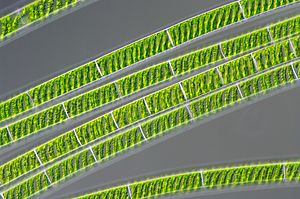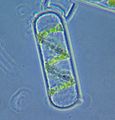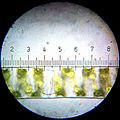Spirogyra facts for kids
Quick facts for kids Spirogyra |
|
|---|---|
 |
|
| Spirogyra with its characteristic helically arranged chloroplasts | |
| Scientific classification | |
| Kingdom: | |
| Division: | |
| Class: | |
| Order: | |
| Family: | |
| Genus: |
Spirogyra
Link in C. G. Nees, 1820
|
| Type species | |
| Spirogyra porticalis (O. F. Müller) Dumortier
|
|
| Species | |
|
Over 400; see text |
|
| Synonyms | |
|
|
Spirogyra is a type of green alga. People often call it water silk, mermaid's tresses, or blanket weed. It gets its name from the spiral shape of its chloroplasts. Chloroplasts are the parts inside plant cells that help them make food using sunlight. Spirogyra is a long, thin, thread-like alga. You can find it in freshwater places like ponds and lakes. There are more than 400 different kinds of Spirogyra around the world. These algae are usually about 10 to 100 micrometers wide. They can grow to be several centimeters long.
Contents
What is Spirogyra like?
Spirogyra is very common in clear, nutrient-rich water. This kind of water is called eutrophic. It forms slimy, green, thread-like masses. In spring, Spirogyra grows underwater. When it gets enough sunlight and warmth, it makes a lot of oxygen. This oxygen forms bubbles that get stuck in the tangled threads. These bubbles make the slimy green mats float to the surface. That's when you can easily see them. Each Spirogyra cell has a cell wall, a nucleus, and spiral chloroplasts. It also has special parts called pyrenoids.
Reproduction
Spirogyra can make new algae in two ways: sexually and asexually.
Asexual Reproduction
In asexual reproduction, Spirogyra simply breaks into smaller pieces. This is called fragmentation. Each piece can then grow into a new, full-length thread. This happens through a process called cell division. New cells are added along the length of the filament.
Sexual Reproduction
Sexual reproduction in Spirogyra involves two cells joining together. There are two main types:
- Scalariform Conjugation: This happens when two or more Spirogyra threads line up next to each other. Cells from opposite threads grow small tubes towards each other. These tubes meet and form a passage called a conjugation canal. The inside material (cytoplasm) from one cell, acting like the male, moves through this tube. It then joins with the cytoplasm of the other cell, which acts like the female. When the two cell contents mix, they form a new cell called a zygospore. This zygospore can survive harsh conditions and later grow into a new Spirogyra thread.
- Lateral Conjugation: This type of reproduction happens within a single Spirogyra thread. Two cells that are right next to each other on the same thread form small tubes. These tubes connect to create a conjugation canal. The cytoplasm from one cell moves into the other cell through this canal. Just like in scalariform conjugation, the two cytoplasms mix to form a zygospore.
The main difference is that scalariform conjugation needs two separate threads. Lateral conjugation happens between two cells on the same thread.
Images for kids
See also
 In Spanish: Spirogyra para niños
In Spanish: Spirogyra para niños








